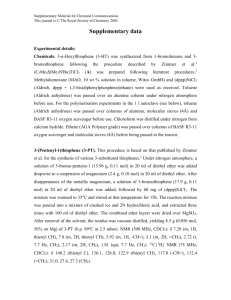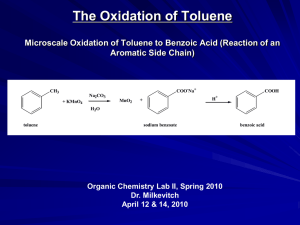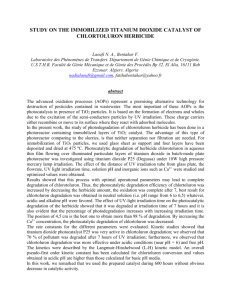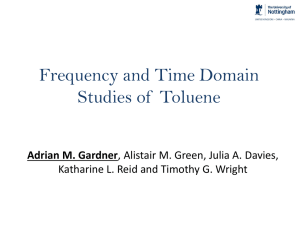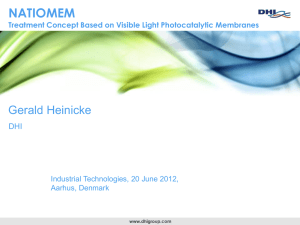1003009
advertisement
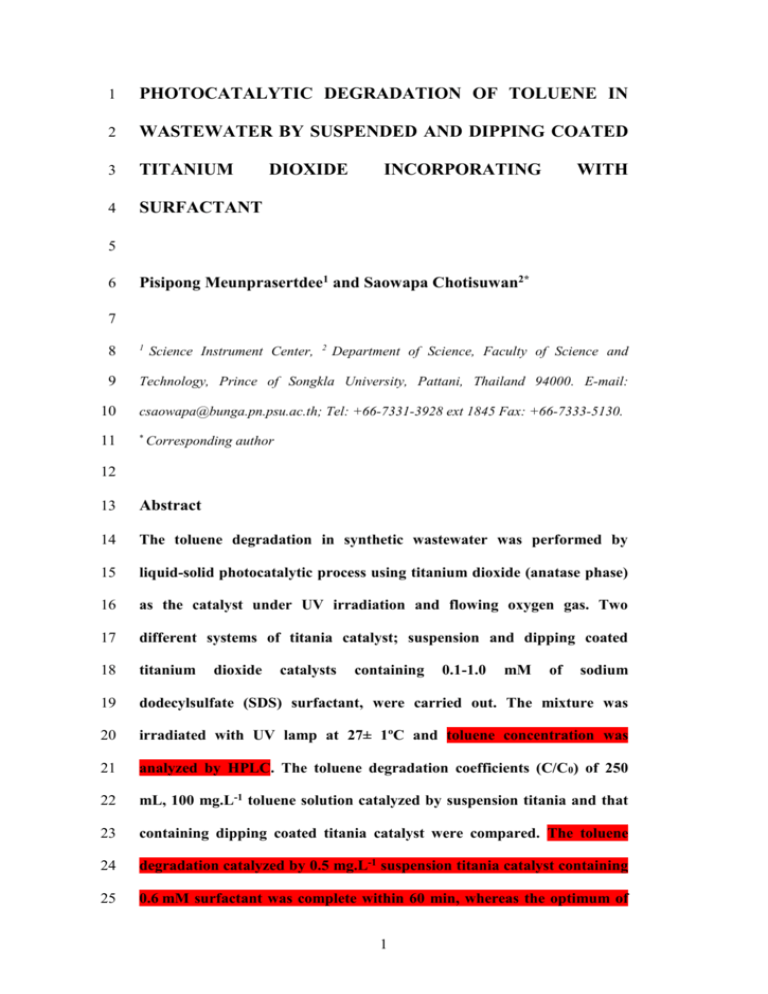
1 PHOTOCATALYTIC DEGRADATION OF TOLUENE IN 2 WASTEWATER BY SUSPENDED AND DIPPING COATED 3 TITANIUM 4 SURFACTANT DIOXIDE INCORPORATING WITH 5 6 Pisipong Meunprasertdee1 and Saowapa Chotisuwan2* 7 8 1 9 Technology, Prince of Songkla University, Pattani, Thailand 94000. E-mail: 10 csaowapa@bunga.pn.psu.ac.th; Tel: +66-7331-3928 ext 1845 Fax: +66-7333-5130. 11 * Science Instrument Center, 2 Department of Science, Faculty of Science and Corresponding author 12 13 Abstract 14 The toluene degradation in synthetic wastewater was performed by 15 liquid-solid photocatalytic process using titanium dioxide (anatase phase) 16 as the catalyst under UV irradiation and flowing oxygen gas. Two 17 different systems of titania catalyst; suspension and dipping coated 18 titanium 19 dodecylsulfate (SDS) surfactant, were carried out. The mixture was 20 irradiated with UV lamp at 27± 1ºC and toluene concentration was 21 analyzed by HPLC. The toluene degradation coefficients (C/C0) of 250 22 mL, 100 mg.L-1 toluene solution catalyzed by suspension titania and that 23 containing dipping coated titania catalyst were compared. The toluene 24 degradation catalyzed by 0.5 mg.L-1 suspension titania catalyst containing 25 0.6 mM surfactant was complete within 60 min, whereas the optimum of dioxide catalysts containing 1 0.1-1.0 mM of sodium 26 the toluene degradation coefficient for the dipping coated titania system 27 containing 1.0 mM surfactant was 0.20 at 60 min. However, the maximum 28 toluene degradation based on specific activity of the dipping coated 29 titania with 1.0 mM SDS was 1,000 mg.g-1 titania, higher than that of the 30 suspended titania which was 200 mg.g-1. Furthermore, the toluene 31 degradation by the dipping coated titania is cost saving and convenient to 32 be reused. 33 Keywords: Photocatalytic, TiO2, toluene, wastewater, surfactant 34 35 Introduction 36 Water pollutions have been occurred from releasing of non-treatment 37 toxic effluents, especially the organic solvents such as benzene derivatives, 38 aliphatic compounds, phenol compounds, chlorohydrocarbon etc to the 39 environment. Toluene is a benzene derivative, widely used as industrial 40 chemical to synthesize many chemical compounds, i.e. benzoic acid, 41 benzaldehyde, benzyl alcohol etc. Toluene is still used as a solvent for a 42 variety of industries as well as paint, chemical reactants, rubber, printing ink, 43 adhesives, fuel mixer, plastic etc (Marci et al., 2003). In addition, toluene has 44 been used in various fields of academic research such as organic solvent in 45 chemical, rubber and polymer laboratory, therefore it can contaminate 46 wastewater from many industries and laboratories. The concentration of 47 toluene in the wastewater collected from chemical laboratory at Prince of 48 Songkla University (PSU), Pattani, Thailand was about 100 mg.L-1. It has 49 been reported that the threshold Limit Value-Time Weighted Average (TLV- 50 TWA) of ACGIH limit is 50 mg.L-1, NIOSH limit is 100 mg.L-1 and OSHA 2 51 limit is 200 mg.L-1 (MSDS, 2006). Toluene is the most toxic of BTEX group, 52 it is chronic and toxic chemical for human and environment. The oral rat LD50 53 of toluene is 636 mg.kg-1 (MSDS, 2006). Many methods have been reported to 54 reduce releasing waste toluene to the environment (Marci et al., 2003; Duarte, 55 et al., 2004; Hamdi et al., 2004; Hamed et al., 2004; Pernyeszi and Dékány, 56 2004; Ying et al., 2005; Zang, 2005; Zhang, 2005; García et al., 2006; Negishi 57 et al., 2006; Saien and Nejati, 2007). 58 Many strategies have been studied to treat organic waste that 59 contaminates water. Some methods give low efficiency compared to the 60 reaction rate, such as biodegradation by the microorganism (Hamed et al., 61 2004; Ying et al., 2005). The cost of many methods such as electron beam 62 irradiation method (Duarte, et al., 2004) or adsorption method (Hamdi et al., 63 2004) is high and difficult to control. 64 Photocatalytic oxidation (PCO) is a method that offers various 65 advantages compared to other methods. PCO can be done at room temperature 66 and atmospheric pressure and under UV irradiation. Titanium dioxide (TiO2) 67 or titania has been used as photocatalyst with high efficiency for organic waste 68 degradation and it can be regenerated. Three phases of titania are anatase, 69 rutile and brookite. Anatase is the most effective phase for degrading organic 70 compounds in photocatalytic process (Zang, 2005). The photocatalytic 71 oxidation method has been used in two systems, liquid-solid and gas-solid 72 systems. For the liquid-solid photocatalytic system, suspended titania system 73 (Pernyeszi and Dekany, 2004; García et al., 2006; Saien and Nejati, 2007) and 74 dipping coated titania on the supports (Marci et al., 2003; Zhang, 2005; 3 75 Negishi et al., 2006) have been studied for toluene degradation with high 76 efficiency. 77 Recently, using surfactant to enhance the photocatalytic reaction rate 78 for low soluble compound degradation has been reported. The mixture of 164 79 ppm toluene and asphatene could be degraded in 1 h by using suspended P25 80 TiO2 containing 1% H2O2 and sodium dodecylsulfate (SDS) (Pernyeszi and 81 Dekany, 2004). In addition, dibenzo-thiophene (DBT) was highly degraded by 82 TiO2/UV light with adding Triton X-100 in aqueous solution (Vargas and 83 Núñez, 2008). 84 The aim of this work was to investigate of toluene degradation in 85 synthetic wastewater by liquid-solid photocatalytic process using suspended 86 and dipping coated titania. In order to enhance the toluene degradation rate, 87 sodium dodecylsulfate (SDS) surfactant was added to the mixture. The 88 photocatalytic processes were monitored as toluene degradation coefficient 89 (C/C0). The concentration of toluene in synthetic wastewater was prepared 90 nearly to toluene concentration in real wastewater collected from chemical 91 laboratory at Prince of Songkla University (PSU), Pattani, Thailand. 92 93 Materials and Methods 94 Reagents and Materials 95 The chemicals have been used in this work: Titanium dioxide ( AR 96 grade, Merck, Germany), sodium dodecylsulfate (AR grade, Riedel-de Haen, 97 USA), toluene ( 99.99%, AR grade, Fisher Scientific, UK) , sulfuric acid (AR 98 grade, Merck, Germany) oxygen gas (99.9%, Pattani Oxygen production, 99 Thailand), deionized water, and acetonitrile (HPLC grade, LabScan, Poland). 4 100 The equipments such as mercury UV lamp ( 20 W, Philips, Holland) 101 500 mL, reaction kettle (Quickfit, England) , 0.45 m nylon membrane filter 102 (47 mm diameter, Sartorius, Germany), and stainless steel S304 screen (Thai 103 Prasit Textile, Thailand) were used in this work. 104 105 Analysis of Toluene in Wastewater 106 Wastewater was collected from laboratory wastewater reservoir of 107 Department of Science, Faculty of Science and Technology, Prince of Songkla 108 University, Pattani, Thailand. Wastewater sample was filtered through 0.45 109 m nylon membrane filter and analyzed for toluene quantity by High 110 Performance Liquid Chromatography (HPLC, HP1100, Agilent, USA) 111 equipped with PinnacleII-C8 column, 150 x 4.6 mm (Restek, USA), 12.5 x 4.6 112 mm Zorbax SB-C18 guard column, diode array detector (Agilent, USA) at 254 113 nm, 60% acetonitrile mobile phase with 1 mL.min-1 flowing and 20 L of 114 injection volume. 115 116 Synthetic Wastewater and Catalyst Preparation 117 Synthetic wastewater with similar toluene concentration in laboratory 118 wastewater was prepared. Aqueous toluene solution (100 mg.L-1, 250 mL) was 119 added with 0.1, 0.2, 0.3, 0.4, 0.6, 0.8 and 1.0 mM SDS solution. The 120 controlled sample was prepared without SDS, titania and UV irradiation. 121 Titanium dioxide powder was suspended in synthetic wastewater to 122 contain 0.5 mg.L-1 titania. The solution was stirred by magnetic stirrer at 60 123 rpm to guarantee a satisfactory suspension of the photocatalyst and the 124 uniformity of the reacting mixture for suspension titania system. 5 125 For dipping coated titania, 4 stainless steel S304 screens (3.8 x 2.8 cm) 126 were pretreated with 30% sulfuric acid for 2 h in order to increase the 127 roughness of surface (Giornelli et al., 2006). After that, they were sonicated by 128 ultrasonic bath (950D, Crest, Malaysia) for 30 min in deionized water to 129 eliminate acidic trace before coated with 0.3:10 (w/v) of titania in isopropanol. 130 Coated screens were dried at 80°C and calcined at 600ºC for 2 h. The coated 131 screens were attached to a propeller connecting with 60 rpm mechanical 132 stirrer. The propeller of photoreactor consists of four vertical rectangle blades 133 (3.5 x 2.5 cm inner; 3.8 x 2.8 cm outer; 0.3 cm thickness). Titania quantities 134 on the four coated screens determined by weighing before and after coating 135 were about 0.02 g in 250 mL of synthetic wastewater. 136 137 Photocatalytic Process 138 The 250 mL of synthetic wastewater was stirred in darkness for 30 min 139 before starting the reaction. Pyrex photoreactor was set up as shown in Figure 140 1. Toluene in synthetic wastewater was irradiated by Hg UV lamp which 141 produced UV light at wavelength 290-400 nm, the distance between UV lamp 142 and reactor was 10 cm. The radiation energy imprinting gave an average value 143 of 420 W.cm-2 measured by a UV radiation meter (Digicon D20, Taiwan). 144 Percentage transmittance of pyrex glass at 388 nm is about 92% (Corning 145 Incorporated, 2009). Pure oxygen gas was added into the solution with flow 146 rate 30 mL.min-1 at room temperature (27± 1ºC). The synthetic wastewater 147 was collected from the reactor every 15 min, then filtered through millipore 148 membrane and toluene concentration was determined by HPLC. The HPLC 149 analysis condition was the same as the analysis of toluene in wastewater. 6 150 Percentage of titania remained on the screens after treatment was determined 151 by weighing before and after reaction. 152 153 Characterization of Phase and Morphology of Titania 154 The calcined titania at 600°C and commercial titania powder for 155 suspended titania and dipping coated titania were analyzed by X-ray 156 diffractrometer (D5005, BRUKER) using Cu K radiation and scanning 157 electron microscope (JSM6400, JEOL) to characterize phase and morphology. 158 159 Results and Discussion 160 Toluene Content in Wastewater 161 Toluene concentration in laboratory wastewater analyzed by HPLC 162 was found to be 104.4 mg.L-1, higher than Threshold Limit Value-Time 163 Weighted Average (TLV-TWA) of ACGIH limit (50 mg.L-1) and NIOSH 164 limit (100 mg.L-1), but lower than OSHA limit (200 mg.L-1) (MSDS, 2006). 165 Toluene is chronic and toxic chemical for human and environment since the 166 oral rat LD50 of toluene is 636 mg.kg-1 (MSDS, 2006). The toluene 167 contaminated wastewater must be treated before release to the environment. 168 169 170 Degradation of Toluene in Wastewater by Photocatalytic Process The monitoring of toluene degradation was determined by toluene 171 degradation coefficient (C/C0), calculated 172 concentration of toluene at anytime during photodegradation and initial 173 toluene concentration; 174 7 from the ratio between 175 C/C0 = Concentration of toluene at anytime Initial concentration of toluene 176 177 In the absence of the UV radiation, the photocatalytic degradation of 178 toluene in the first 30 min by both suspended and dipping coated titania was 179 low. The toluene degradation coefficient (C/C0) were about 0.86-0.94 (Figures 180 2-3) resulting from the adsorption of toluene on the titania surface. It was 181 supported that the degradation of toluene required UV radiation. In Figures 2 182 and 3, during the first 30 min of photocatalytic reaction, C/C0 in titania 183 suspension and dipping coat types added with 0.4 mM SDS decreased rapidly 184 from 0.93 to 0.61 and 0.77, respectively. After that, the degradation rates 185 slowed down. The toluene degradation coefficients (C/C0) at 60 min for 186 suspension titania mixed with 0.1, 0.2, 0.3, 0.4, 0.6, 0.8 and 1.0 mM of SDS 187 were 0.27, 0.22, 0.18, 0.03, 0.0, 0.0 and 0.0, respectively (Figure 2). The 188 system containing dipping coated titania gave 0.52, 0.46, 0.41, 0.35, 0.29, 0.29 189 and 0.28 C/C0 at the same SDS concentration, respectively (Figure 3). 190 Complete toluene degradation was only observed in suspended titania 191 photocatalytic type incorporating with 0.6-1.0 mM SDS which could degrade 192 toluene completely at 60 min. On the other hand, dipping coated titania 193 photocatalytic system showed nearly complete toluene degradation (C/C0 ≈ 194 0.02) at 150 min reaction time for solution containing 0.6-1.0 mM SDS 195 (Figure 3). 196 SDS addition can improve toluene solubility in aqueous phase, thus 197 increasing SDS concentration in solution may result in increasing rate of 198 toluene degradation as shown in Figures 2 and 3. The toluene solutions 199 without SDS addition slightly degraded and reached steady state at 135 min. 8 200 The increase of degradation rate could be explained by a higher solubility of 201 toluene in aqueous media containing surfactant which led to more adsorption 202 on the titania surface. Thus, toluene molecules in this system can be adsorbed 203 on the titania surface higher than the system without surfactant. The results 204 agreed with literatures that the photocatalytic reaction was more favorable in 205 the presence of surfactant. (Marci et al., 2003; Pernyeszi and Dékány, 2004). 206 At the initial reaction time (0-30 min), toluene concentration decreased 207 rapidly because many toluene molecules in the solution were adsorbed on 208 active sites of titania surface. In addition, toluene molecule was converted to 209 intermediates and then these intermediates were adsorbed on the titania 210 surface, resulting in a decrease of titania active sites (Negishi et al., 2006). 211 However, an increase of SDS concentration which was less than 8 mM could 212 decrease the adsorption of intermediates on the titania surface (Pernyeszi and 213 Dékány, 2004). This was supported by an increase of toluene degradation rates 214 when increasing the amount of SDS. Moreover, a release of the intermediates 215 during photocatalytic reaction of toluene such as benzaldehyde, benzoic acid 216 and benzyl alcohols from titania surface into media phase could be increased 217 for the system containing SDS. 218 The toluene degradation efficiencies catalyzed by dispersed and 219 dipping coated titania at 60 min in Figure 2 and 3 were compared. The 220 degradation of toluene catalyzed by suspension titania was better than that by 221 dipping coated titania. However, the amount of titania in both systems were 222 different. The titania amount in suspension system was about 0.125 g in 250 223 mL solution which was higher than that in dipping coated system, 0.020 g in 224 the same volume of solution. Thus, the specific activities of titania were 9 225 calculated to compare these systems as shown in figure 4. The specific activity 226 at 60 min reaction time of suspended titania to degrade toluene were 68-200 227 mg.g-1 (mg toluene per gram titania) incorporating with 0.0-1.0 mM of SDS 228 concentration. Whereas the specific activity of dipping coated titania were 229 575-1,000 mg.g-1 at the same SDS concentration. The toluene degradation 230 activity of dipping coated titania at 1,000 mg.g-1 titania containing 1.0 mM 231 SDS could degrade 100 mg.L-1 toluene solution in 1 h and toluene remained 232 about 20 mg.L-1. The degradation of toluene by dipping coated titania was 233 better than that of suspension titania because of light scattering and screening 234 effects of titania particles. These effects reduced the specific activity of the 235 catalysts (Wei et al., 2009; Nam et al., 2009). The excess titania particles in 236 the solution cause turbidity of aqueous media which could be observed during 237 the experiments. Beside light scattering and screening effects, particle 238 aggregation of titania might also reduce the catalytic activity as well (Jiang et 239 al., 2008). Therefore, the specific activity of titania for toluene degradation 240 catalyzed by suspended titania was lower than that by dipping coated titania. 241 At appropriate SDS concentration of 0.6 mM, the suspended titania 242 could completely degrade toluene within 60 min whereas the percentage of 243 toluene degradation using dipping coated titania was about 80% and the 244 toluene was degraded for 95% at 120 min. The toluene concentration remained 245 at 20 mg.L-1 (95% toluene degradation) was lower than the threshold limit of 246 ACGIH, NIOSH and OSHA limit. The degradation time using dipping coated 247 titania is about twice compared to suspended titania system. However, the 248 specific activities of dipping coated titania were higher than those of 249 suspended titania system. Thus, it could be acceptable to develop and use 10 250 dipping coated titania catalyst in the future. Moreover, dipping coated titania 251 is convenient to be reused because the titania particles remained on screens 252 after reaction. The percentage of the titania amount remaining on screens after 253 150 minutes reaction was 87%. 254 255 Photocatalytic Degradation of Toluene on Titania Surface 256 The first step of photocatalytic process is absorption of photon on the 257 titania surface, then the electrons and holes of the catalyst are activated by the 258 appropriate energy from photon and the redox reaction occurs. The 259 wavelength 388 nm gave energy around 3.2 eV which is corresponding to 260 band gap energy of titania. The surface reaction has been proposed (Saien and 261 Nejati (2007). 262 263 TiO2(e-cb) + TiO2( h+vb) TiO2 + h (1) cb = conduction band, vb = valence band 264 Valence band electron was excited and elevated from valence band to 265 conduction band by photon (h) from UV radiation, produced electron (e-cb) 266 and hole (h+vb). Water, oxygen and adsorbed molecules on titania surface were 267 oxidized and gave hydroxyl radical and reacted further to form products 268 (Maira et al., 2001). 269 The liquid-solid photocatalytic system with bubbling of oxygen gas 270 produced hydroxyl radical (HO•) and superoxide radical (O2•-). Adsorbed 271 toluene on the titania surface was oxidized by HO• and O2•-, then decomposed 272 into intermediates, e.g. benzoic acid, benzyl alcohol, and benzaldehyde. The 273 final products of the reaction will be carbon dioxide and water. Toluene could 274 be degraded directly to carbon dioxide and water (Marci et al., 2003). 11 275 Some of the intermediates could be adsorbed on the active sites of 276 titania and degraded via oxidation reaction to carbon dioxide and water as 277 shown in Figure 5. 278 279 Phase and Morphology of Titania 280 The phases of both titania types used in this work were characterized 281 by X-ray diffraction (XRD). Figure 6 shows XRD patterns of calcined titania 282 at 600°C and commercial titania powder, Both XRD patterns of titania powder 283 contained anatase (1 0 1), (0 0 4), and (2 0 0) with 2 at 25.3°, 38°, and 48°, 284 respectively (Zang, 2005). The phase of titania catalysts did not transform 285 from anatase to rutile phase after calcinations at 600°C. The anatase phase 286 gives high catalytic efficiency compared to rutile phase (Zang, 2005). The 287 SEM images of commercial titania powder and titania particles after 288 dispersion in isopropanol and calcination at 600°C (Figure 7a and 7b) show 289 the spherical particles about 0.2 m diameter, porous and homogeneous of 290 titania particles. 291 292 Conclusion 293 The specific activities of dipping coated titania for photocatalytic 294 toluene degradation in synthetic wastewater mixed with SDS surfactant were 295 better than that of suspended titania. The specific activity of dipping coated 296 titania with 1.0 mM SDS concentration was 1,000 mg.g-1 titania at 1 h of 297 reaction and toluene remained about 20 mg.L-1. For the suspended titania 298 system, the degradation of 100 mg.L-1 toluene solution, 250 mL incorporating 299 with 0.6 mM SDS was complete within 60 min of reaction. It is interesting to 12 300 develop the dipping coated titania system since the amount of dipping coated 301 titania in the system was less than 6 times of suspended titania and it is 302 convenient to be reused. 303 304 Acknowledgement 305 This research was financially supported by graduated school, Prince of 306 Songkla University, Pattani campus. XRD and SEM characterization were 307 carried out at Suranaree University of Technology. 308 309 References 310 Corning Incorporated. (2009). Properties of PYREX®, PYREXPLUS® and 311 low Actinic PYREX Code 7740 Glasses. USA: Available from: 312 http://www.corning.com/lifesciences/. Accessed date: Sep 21, 2009. 313 Duarte, C.L., Geraldo, L.L., Junior, O.A.P., Borrely, S.I., Sato, I.M., and 314 Sampa, M.S.O. (2004). Treatment of effluents from petroleum 315 production by electron beam irradiation. Radiat. Phys. Chem., 71:445- 316 447. 317 García, M.F., Fuerte, A., Hernández-Alonso, M.D., Soria, J., and Arias, M. 318 (2006). Platinization of sunlight 319 photocatalysts. J. Catal., 245:84-90. sctive Ti–W mixed oxide 320 Giorneli, T., Löfberg, A., and Bordes-Richard, E. (2006). Preparation and 321 characterization of VOx/TiO2 catalytic coatings on stainless steel plates 322 for structured catalytic reactors. Appl. Catal. A-Gen., 305:197-203. 13 323 Hamdi, B., Houari, M., Hamoudi, S.A., and Kessáissia. Z. (2004). Adsorption 324 of some volatile organic compounds on geomaterials. Desalination, 325 166:449-455. 326 Hamed, T.A., Bayraktar, E., Mehmetoglu, U., and Mehmetoglu, T. (2004). 327 The biodegradation of benzene, toluene and phenol in a two-phase 328 system. Biochem. Eng. J., 19:137-146. 329 Jiang, Y., Sun, Y., Liu, H., Zhu, f. and Yin, H. (2008). Solar photocatalytic 330 decolorization of C.I. Basic Blue 41 in an aqueous suspensión of TiO2- 331 ZnO. Dyes Pigments., 72:77-83. 332 Marci, G., Addamo, M., Augugliaro, V., Coluccia, S., García, L.E., Loddo, V., 333 Martra, G., Palmisano, L., and Schiavello, M. (2003). Photocatalytic 334 oxidation of toluene on irradiated TiO2: Comparison of degradation 335 performance in humidified air, in water and in water containing a 336 Zwitterionic surfactant. J. Photoch. Photobio. A, 160:105-114. 337 Maira, A.J., Yeung, K.L., Soria, J., Coronado, J.M., Belver, C., Lee, C.Y and 338 Augugliaro, V. (2001). Gas-phase photo-oxidation of toluene using 339 nanometer-size TiO2 catalysts. Appl. Catal. B-Environ., 29: 327-336. 340 Material Safety Data Sheet [MSDS]. (2006). Safety data of toluene. UK: 341 Safety Officer in Physical Chemistry at Oxford University. Available 342 from: www.pcl.ox.ac.uk /MSDS/TO/toluene. Accessed date: Oct 21, 343 2007. 344 Nam,W., Woo, K. and Han, G. (2009). Photooxidation of anionic surfactant 345 (sodium lauryl sulfate) in a three-phase fluidized bed reactor using 346 TiO2/SiO2 photocatalyst. J. Ind. Eng. Chem., 15:348-353. 14 347 Negishi, N., He, F., Matsuzawa, S., Takeuchi, K., and Ohno, K. (2006). Wave- 348 guide type photoreactor for water purification. C. R. Chemie, 9:822- 349 828. 350 Pernyeszi, T. and Dékány, I. (2004). Photocatalytic degradation of 351 hydrocarbons by bentonite and TiO2 in aqueous suspensions containing 352 surfactants. Colloid. Surface. A, 230:191-199. 353 Saien, J. and Nejati, H. (2007). Enhance photocatalytic degradation of 354 pollutants in petroleum refinery wastewater under mild condition. J. 355 Hazard. Mater., 148:491-495. 356 357 Vargas, R. and Núñez, O. (2008). The photocatalytic oxidation of dibenzothiophene (DBT). J. Mol. Catal. A: Chem., 294:74-81. 358 Wei, L., Shifu, C., Wei, Z. and Sujuan, Z. (2009). Titanium dioxide mediated 359 photocatalytic degradation of methamidophos in aqueous phase. J. 360 Hazard. Mater., 164:154-160. 361 Ying, X.J, Ying, H.H., Bo, Z.B., and Yi, Q. (2005). Effects of adding inert 362 spheres into the filter bed on the performance of biofilters for gaseous 363 toluene removal. Biochem. Eng. J., 23:123-130. 364 365 Zhang, R.B. (2005). Photodegradation of toluene using silica-embedded titania. J. Non-Cryst. Solids, 351:2129-2132. 366 367 368 369 370 371 15 372 Figure legends 373 Figure 1. Toluene degradation reactor using (a) suspended and (b) dipping 374 coated titania 375 Figure 2. Toluene degradation coefficient of toluene degradation by suspended 376 titania photocatalytic process from 30 min before starting reaction to 377 150 min of reaction containing SDS; control (x), 0.0 mM (), 0.1 378 mM (), 0.2 mM (), 0.3 mM (), 0.4 mM (), 0.5 mM (), 0.6 379 mM (■), 0.8 mM (▲), and 1.0 mM () 380 Figure 3. Toluene degradation coefficient of toluene degradation by dipping 381 coated titania photocatalytic process from 30 min before starting 382 reaction to 150 min of reaction containing SDS; control (x), 0.0 mM 383 (), 0.1 mM (), 0.2 mM (), 0.3 mM (), 0.4 mM (), 0.5 mM 384 (), 0.6 mM (■), 0.8 mM (▲), and 1.0 mM () 385 Figure 4. Specific activities of titania for toluene photodegradation at 60 min 386 reaction time catalyzed by suspended and dipping coated titania 387 containing various SDS concentration 388 389 390 391 392 393 Figure 5. Proposed photocatalytic reaction of toluene degradation on titania surface during UV radiation Figure 6. X-ray diffraction patterns of (a) calcined titania (at 600°C) and (b) commercial titania powder for photocatalytic process Figure 7. SEM images of (a) commercial titania and (b) calcined titania powder (at 600°C) (x7,000) 394 16
